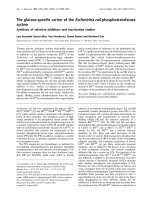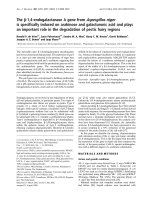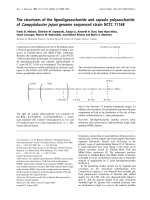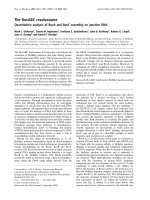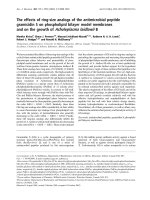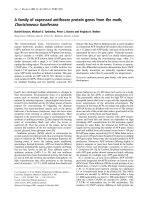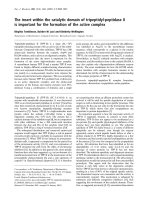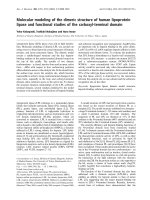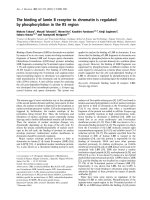Báo cáo y học: " The aftermath of the Merck''''s HIV vaccine trial" ppt
Bạn đang xem bản rút gọn của tài liệu. Xem và tải ngay bản đầy đủ của tài liệu tại đây (580.02 KB, 6 trang )
BioMed Central
Page 1 of 6
(page number not for citation purposes)
Retrovirology
Open Access
Commentary
The aftermath of the Merck's HIV vaccine trial
Enrico Iaccino
†1
, Marco Schiavone
†2
, Giuseppe Fiume
†1
, Ileana Quinto
1,2
and
Giuseppe Scala*
1,2
Address:
1
Department of Experimental and Clinical Medicine, University of Catanzaro "Magna Graecia", 88100, Catanzaro, Italy and
2
Department
of Biochemistry and Medical Biotechnology, University of Naples "Federico II", 80131, Naples, Italy
Email: Enrico Iaccino - ; Marco Schiavone - ; Giuseppe Fiume - ;
Ileana Quinto - ; Giuseppe Scala* -
* Corresponding author †Equal contributors
Abstract
The recently released results of the Merck's Phase IIb "test-of concept" vaccine trials have shown
no protection from HIV-1 infection in the vaccinated group compared with a control group
vaccinated with placebo. The study was designed to test the Merck's MRKAd5 trivalent candidate
vaccine. The vaccine formulation was expected to stimulate a HIV-specific T cell immune response
and to either prevent infection, or to reduce the levels of the viral load in vaccinated subjects. Upon
the first evaluation of the interim data, the independent Data and Safety Monitoring Board (DSMB)
underscored no protection from HIV-1 infection in the vaccine-inoculated volunteers compared
with the control group; accordingly, the vaccine trial was stopped. This disappointing outcome
warrants a critical analysis of the current vaccine studies and calls for a renewed effort toward a
rational design of novel immunogens to be tested in large primate trials.
Background
The release of the results from the phase III efficacy trial
sponsored by Merck, HIV Vaccine Trials Network (HVTN)
and the NIAID-NIH has shattered the community of sci-
entists engaged in the field of HIV vaccine. The STEP vac-
cine trial (also referred to as HVTN 502 or Merck V520-
023) relied on recombinant adenovirus serotype 5 (rAD5)
as a vaccine vector to induce a strong anti-HIV T-cell
immunity. The trial included three rAD5 vectors express-
ing gag, pol or nef coding sequences and was expected to
either prevent vaccinees from HIV infection, or to reduce
significantly the plasma viral loads at post-infection set
point. The STEP study enrolled 3,000 volunteers at sites in
Australia, Brazil, Canada, the Dominican Republic, Haiti,
Jamaica, Peru, Puerto Rico and the United States. The first
set of results, released in September 2007, showed no pro-
tection from infection in rAD5-gag, rAD5pol and rAD5nef
vaccinated individuals; surprisingly, the vaccinated cohort
showed an increased number of new infections compared
with the control group [1]. In fact, an independent Data
and Safety Monitoring Board (DSMB) found 24 cases of
HIV infection among the 741 volunteers who received at
least one dose of the investigational vaccine compared
with 21 cases of HIV infection among the 762 volunteers
who were vaccinated with placebo. In volunteers who
received at least two vaccinations, the DSMB found 19
cases of HIV infection among the 672 volunteers who
received the investigational vaccine and 11 instances of
HIV infection among the 691 subjects who received the
placebo. Surprisingly, the STEP results underscored that
people who got the vaccine were more likely to get
infected with HIV. Moreover, the increased susceptibility
to HIV was preeminent in subjects with pre-existing
immunity (antibodies) to adenovirus type 5 (Ad5) (Table
Published: 2 July 2008
Retrovirology 2008, 5:56 doi:10.1186/1742-4690-5-56
Received: 17 April 2008
Accepted: 2 July 2008
This article is available from: />© 2008 Iaccino et al; licensee BioMed Central Ltd.
This is an Open Access article distributed under the terms of the Creative Commons Attribution License ( />),
which permits unrestricted use, distribution, and reproduction in any medium, provided the original work is properly cited.
Retrovirology 2008, 5:56 />Page 2 of 6
(page number not for citation purposes)
1). As a consequence, enrollments and vaccinations were
discontinued. It is noteworthy that the STEP trial was
stopped before completing the immunizations in most of
the volunteers and that the reported infections occurred in
subjects with incomplete vaccine regimen, thus preclud-
ing a fair evaluation of the vaccine protection. In addition,
the control groups were not inoculated with empty vector
and do not act as true controls to evaluate the potential
enhancement of infection. Nevertheless, the available
results do suggest that multiple immunizations with a sin-
gle immunogenic vector may stimulate a harmful anam-
nestic response.
Discussion
These results represent a grim setback for the HIV vaccine
field; however, they came with no surprise within the vac-
cine community. Indeed, such an outcome was predicted
given the nature of the HIV-1 infection and by previous
preclinical trials in monkeys. HIV-1 infection is character-
ized by an acute phase of infection where the virus inte-
grates into the host CD4-positive cell genome and
establishes an early viral reservoir characterized by a HIV
latency in memory CD4+ T cells [2,3]. However, upon a
stochastic activation of CD4 T cells by multiple stimuli,
the HIV latency is overcome by the Tat-mediated transac-
tivation of the LTR, which promotes the virus gene tran-
scription and production of infection-competent viral
particles that spread to uninfected T cells thereby reconsti-
tuting the viral reservoir [3-6]. Reactivation of viral infec-
tion occurs preferentially in activated memory T cells [7-
9], and results in a limited T-cell repertoire and in a
reduced immune competence [10]. In this setting, the
immune system mounts a robust anti-HIV T cells immune
response that decreases significantly the acute plasma
viremia to a lower set point; however, shortly after the pri-
mary infection, the T cell-mediated immune pressure gen-
erates escape mutants that mediate new rounds of
infection that result in increased virus spreading and fur-
ther deletion of CD4
+
susceptible cells [11-14] (shown in
Figure 1, 2).
Antibody-mediated immune response is elicited after few
weeks from primary infection; however, the anti-HIV anti-
bodies show a poly-specificity for non-neutralizing, linear
epitopes [15]. Antibodies specific for conserved, confor-
mational epitopes are elicited at later stage and may play
a favorable role by decreasing the plasma viremia [16-18].
In addition, anti-HIV envelope antibodies also contribute
to the containment of infected T cells by triggering anti-
body-mediated cell cytotoxicity (ADCC; [19]). As in the
case of virus escape mutants promoted by the T-cell
immune pressure, escape mutants are generated in pres-
ence of epitope specific antibodies [20].
In this setting, most vaccine trials in humans have been
initiated under the assumption that the immune response
to HIV-1 differs from the one elicited in non-human pri-
mates upon infection with SIV or SHIV strains; by infer-
ence, only vaccine trials in humans would validate vaccine
candidates. Consistently, a large number of monkey vac-
cine studies have been overlooked despite the evidence
that the monkeys' models of SIV/SHIV infection mimic
well the natural HIV-1 infection in human subjects.
Indeed, monkeys infected with SIV or SHIVs show levels
of viremia comparable with the ones experienced by HIV-
infected subjects in the course of the primary infection
and at the subsequent set points [21,22]; CD4 activated T
cells are the main susceptible cell type and the involved
anatomical districts, mucosal sites and lymphoid tissues,
are similar [2]; the functional characteristics of the mon-
keys' immune response do not differ significantly from
the one elicited in humans both at the time of primary
infection and at the later stage of the immune deficiency
[13,23]; the T cell-mediated and the antibody immune
response are comparable with the ones elicited in humans
infected with HIV-1 strains and give rise to escape viral
mutants, as reported in HIV-1 infected subjects
[12,23,24]. Relevant to the vaccine field, several monkey
studies have documented that passive transfer of neutral-
izing MAbs induced protection from systemic and
mucosal challenge [25-27]. This evidence indicates a nar-
row path to a successful HIV vaccine based on the induc-
Table 1: Rates of HIV-1 infections in the vaccinees and in placebo inoculated volunteers enrolled in the STEP vaccine trial.
No immunity to Ad5 (< 18 units) Medium
immunity to Ad5
(18–200 units)
High immunity to Ad5
(201–1000 units)
Very high immunity
to Ad5 (> 1000 units)
Vaccine
a
20 infected
out of 382 total
8 infected
out of 140 total
14 infected out of
229 total
7 infected out of 163
total
Placebo
b
20 infected out
of 394 total
4 infected
out of 142 total
7 infected out of 229
total
2 infected out of 157
total
a. Subjects were inoculated with three rAD5 vectors expressing gag, pol or nef coding sequences.
b. Control subjects were inoculated with an inactive substance (saline). Immunity to Ad5 vector was assessed by ELISA titers of the antibody
response to the rAd5 vector.
Retrovirology 2008, 5:56 />Page 3 of 6
(page number not for citation purposes)
tion of neutralizing antibodies focused on conserved,
constrained envelope domains.
The results coming from previous studies in monkeys,
including the ones promoted by Merck in collaboration
with academic laboratories, may have been largely
ignored. For example consider the world's first 2 phase 3
of HIV-1 vaccine efficacy trials that involved two large
cohorts of HIV-1-uninfected volunteers and were com-
pleted in 2003 [28]. The first trial (VAX004) included
5403 individuals from North America and The Nether-
lands; the cohort included both men who have sex with
men and 308 women at high risk for heterosexual trans-
mission. The second trial (VAX003) was conducted in
Lymph node histomorphology and in situ hybridization in vaccinated monkeys challenged with SHIV-89.6PD viral RNAFigure 1
Lymph node histomorphology and in situ hybridization in vaccinated monkeys challenged with SHIV-89.6PD
viral RNA. A, Representative lymph node of monkey 493 (vaccine protected) [13]. Inguinal lymph nodes were removed at
day 70 after challenge, stained with hematoxylin-eosin and subjected to in situ hybridization. The picture shows the conserved
lymph-node architecture and the presence of secondary follicles with expanded germinal centers and well-represented para-
cortical T cell regions. No SHIV viral RNA is detected. B, Representative lymph node of monkey 480 (unprotected). The pic-
ture shows the follicular depletion, paracortical atrophy and abundant presence of SHIV viral copies. Reprinted by permission
from Macmillan Publishers Ltd: Nature Medicine, Chen, X. et al., 2001, copyright 2001, Nature Publishing Group [13].
Immunohistochemical analysis of CD4
+
T-cell depletion in gut-associated lymphoid tissue of HIV-1-infected individualsFigure 2
Immunohistochemical analysis of CD4
+
T-cell depletion in gut-associated lymphoid tissue of HIV-1-infected
individuals. Immunohistochemical detection of CD4
+
cells of an HIV-negative healthy control, an LTNP, a HAART-naïve
chronically HIV-1-infected patient, and an HIV-1-infected patient who had received HAART for 5 years. Reprinted by permis-
sion from the American Society for Microbiology: Guadalupe, M et al., 2003, Journal of Virology [14].
Retrovirology 2008, 5:56 />Page 4 of 6
(page number not for citation purposes)
2527 infection drug users subjects in Thailand [29,30].
Both the studies relied on recombinant gp120 envelope
protein as the vaccine immunogen. Results from both the
studies indicated that despite a robust antibody response
elicited in vaccinees, no significant protection from HIV-1
infection was detected in the placebo and in the vaccine
inoculated groups [28]. These negative results were antic-
ipated by monkeys studies designed to test a variety of
envelope proteins as anti-HIV immunogens [31]. Among
these pre-clinical studies, the 2001 work of Cho et al. [32]
analyzed the efficacy of mono- or polyvalent envelope
proteins from distinct HIV clade B strains. This study
reported that despite the induction of a strong anti-enve-
lope antibody in vaccinated monkeys, no significant pro-
tection from the SHIV challenge was detected [32].
In the case of the Merck's STEP HIV vaccine trial, the
rationale was based on a preclinical vaccine study in rhe-
sus macaques monkeys (Macaca mulatta) primed with a
plasmid expression vector followed by a boost with Ad5,
a replication-incompetent adenoviral vaccine vector,
which both delivered the SIVmac239 gag gene; the mon-
keys were then challenged with SHIV-89.6P, a pathogenic
strain [33]. The reported results showed high levels of
CD8+ T-cell response by tetramer staining at around week
35 post-challenge and a preserved CD4 T-cells up to day
180. Peak viremia was in the range of 10
6
–10
7
at about
week 3, one log lower than the naïve animals; animals
were followed up to 120 days [33]. In a distinct study,
Barouche et al. reported the case of a monkey immunized
with a plasmid expressing SIV gag plus IL2-Ig protein and
challenged with pathogenic SHIV89.6P [34]; this animal,
which showed low levels of plasma viremia at week 10–
20, developed an escape mutant of the Gag p11C immu-
nodominant epitope and showed a rapid disease progres-
sion and death from AIDS-related syndrome [11]. These
reports are fully consistent with the dynamics of immune
escape of HIV in infected subjects [4,17] and highlight the
need for a vaccine capable of inducing a drastic decrease
of the viremia at the primary infection to prevent the
development of pathogenic escape mutants and the
impairment of the T-cell repertoire.
These representative studies raise the question of the qual-
ity and the extent of the induced immune response.
Indeed, both in monkeys and in human vaccine trials,
positive results were expected from the presence of either
a strong anti-envelope antibody response [28], or a robust
T-cell mediated immunity [1]. Clearly, the main correlates
of protection, anti-envelope antibodies and T-cell induced
activation, need to be re-evaluated. In the case of the anti-
body response, previous studies have assessed the specifi-
cities and concentrations of neutralizing Abs required to
achieve a complete protection from systemic or mucosal
infection [25,26]; however, the major challenge in the
field is to devise novel immunogens to induce antibodies
that match the epitope specificities and affinity of the few
available neutralizing antibodies [35]. In the HIV vaccine
field, the T cell-mediated immune response is assessed by
ELISPOT and polychromatic FACS analysis to detect
cytokine-expressing cells [36] without a functional assess-
ment of T-cell killing activity toward HIV-infected cells.
Thus, the functional parameters of successful T-cell activi-
ties are still missing and may hamper the predictive value
of the ongoing phase 1–2 immunogenicity studies [37-
39].
Conclusion
In the context of the above-mentioned studies, clinical tri-
als have flourished upon societal and economic pressure
from geographic regions heavily affected by AIDS, and
fueled by a large financial support from public and private
institutions [40,41]. However, vaccine trials with the
available immunogens in different vector systems may, at
best, only moderately decrease the levels of plasma
viremia and are not expected to improve the protection
from infection. Likewise, any trial with a suboptimal
immunogen in a high HIV incidence areas may create a
significant number of vaccine breakthroughs and would
raise ethical and financial issues concerning the treatment
of the infected volunteers [42]. In this context, we should
learn from the STEP trial that preclinical studies in mon-
keys are feasible and may anticipate future results in
human subjects. Preclinical studies in non-human pri-
mates should be expanded in terms of number of animals,
study designs to assess potential negative effects and
length of the post-challenge follow-up. Several lessons are
coming form the Merck vaccine study:
a. A vaccine aimed at inducing T-cell immunity will not
prevent primary infection and the establishment of the
viral reservoir;
b. Studies aimed at inducing neutralizing antibodies
should be pursued with even greater efforts toward a
rational development of structurally defined conforma-
tional epitopes, and tested in suitable monkey models;
c. The host immune system will react to both the vector
and the immunogen in an unpredictable way, by activat-
ing a complex immune response that includes the innate
and the epitope-specific immunity;
d. Studies aimed at modeling human behavior in the con-
text of HIV exposure during vaccination should be devel-
oped and used to test for potential vaccine-induced
enhancement of infection.
The STEP vaccine has not provided a successful road to an
effective HIV vaccine; however, it has shown to us that we
still know too little and should learn more.
Retrovirology 2008, 5:56 />Page 5 of 6
(page number not for citation purposes)
Competing interests
The authors declare that they have no competing interests.
Authors' contributions
EI, MS and GF selected the relevant literature. IQ and GS
wrote the commentary. All the authors read and approved
the final manuscript.
Acknowledgements
The authors would like to acknowledge M. Lewis for helpful discussions and
suggestions.
This work was supported by grants from the Italian National Institute of
Health, FP6-EU grant EPIVAC and FP7-EU grant EUROPRISE.
References
1. Press Releases – HIV Vaccine Trials Network [http://
www.hvtn.org/media/pr/step111307.html]
2. Mattapallil JJ, Douek DC, Hill B, Nishimura Y, Martin M, Roederer M:
Massive infection and loss of memory CD4+ T cells in multi-
ple tissues during acute SIV infection. Nature 2005,
434:1093-1097.
3. Jeeninga RE, Westerhout EM, van Gerven ML, Berkhout B: HIV-1
latency in actively dividing human T cell lines. Retrovirology
2008, 5:37.
4. Schiavone M, Quinto I, Scala G: Perspectives for a protective
HIV-1 vaccine. Adv Pharmacol 2008, 56:423-452.
5. Wu Y: HIV-1 gene expression: lessons from provirus and non-
integrated DNA. Retrovirology 2004, 1:13.
6. Marcello A: Latency: the hidden HIV-1 challenge. Retrovirology
2006, 3:7.
7. Sun Y, Permar SR, Buzby AP, Letvin NL: Memory CD4+ T-lym-
phocyte loss and dysfunction during primary simian immun-
odeficiency virus infection. J Virol 2007, 81:8009-8015.
8. Li Q, Duan L, Estes JD, Ma ZM, Rourke T, Wang Y, Reilly C, Carlis J,
Miller CJ, Haase AT: Peak SIV replication in resting memory
CD4+ T cells depletes gut lamina propria CD4+ T cells.
Nature 2005, 434:1148-1152.
9. Chun TW, Nickle DC, Justement JS, Meyers JH, Roby G, Hallahan
CW, Kottilil S, Moir S, Mican JM, Mullins JI, Ward DJ, Kovacs JA, Man-
non PJ, Fauci AS: Persistence of HIV in Gut-Associated Lym-
phoid Tissue despite Long-Term Antiretroviral Therapy. J
Infect Dis 2008, 197(5):714-720.
10. Champagne P, Ogg GS, King AS, Knabenhans C, Ellefsen K, Nobile M,
Appay V, Rizzardi GP, Fleury S, Lipp M, Forster R, Rowland-Jones S,
Sékaly RP, McMichael AJ, Pantaleo G: Skewed maturation of
memory HIV-specific CD8 T lymphocytes. Nature 2001,
410:106-111.
11. Barouch DH, Kunstman J, Kuroda MJ, Schmitz JE, Santra S, Peyerl FW,
Krivulka GR, Beaudry K, Lifton MA, Gorgone DA, Montefiori DC,
Lewis MG, Wolinsky SM, Letvin NL: Eventual AIDS vaccine fail-
ure in a rhesus monkey by viral escape from cytotoxic T lym-
phocytes. Nature 2002, 415:335-339.
12. Barouch DH, Letvin NL: HIV escape from cytotoxic T lym-
phocytes: a potential hurdle for vaccines? Lancet 2004,
364:10-11.
13. Chen X, Scala G, Quinto I, Liu W, Chun TW, Justement JS, Cohen OJ,
vanCott TC, Iwanicki M, Lewis MG, et al.: Protection of rhesus
macaques against disease progression from pathogenic
SHIV-89.6PD by vaccination with phage-displayed HIV-1
epitopes. Nat Med 2001, 7:1225-1231.
14. Guadalupe M, Reay E, Sankaran S, Prindiville T, Flamm J, McNeil A,
Dandekar S: Severe CD4+ T-cell depletion in gut lymphoid tis-
sue during primary human immunodeficiency virus type 1
infection and substantial delay in restoration following highly
active antiretroviral therapy. J Virol 2003, 77:11708-11717.
15. O'Connor DH, Burton DR: Immune responses and HIV: a little
order from the chaos. J Exp Med 2006, 203:501-503.
16. Richman DD, Wrin T, Little SJ, Petropoulos CJ: Rapid evolution of
the neutralizing antibody response to HIV type 1 infection.
Proc Natl Acad Sci USA 2003, 100:4144-4149.
17. Loh L, Petravic J, Batten CJ, Davenport MP, Kent SJ: Vaccination
and timing influence SIV immune escape viral dynamics in
vivo. PLoS Pathog 2008, 4:e12.
18. Frost SD, Liu Y, Pond SL, Chappey C, Wrin T, Petropoulos CJ, Little
SJ, Richman DD: Characterization of human immunodefi-
ciency virus type 1 (HIV-1) envelope variation and neutraliz-
ing antibody responses during transmission of HIV-1 subtype
B. J Virol 2005, 79:6523-6527.
19. Hessell AJ, Hangartner L, Hunter M, Havenith CE, Beurskens FJ,
Bakker JM, Lanigan CM, Landucci G, Forthal DN, Parren PW, Marx
PA, Burton DR: Fc receptor but not complement binding is
important in antibody protection against HIV. Nature 2007,
449:101-104.
20. Wei X, Decker JM, Wang S, Hui H, Kappes JC, Wu X, Salazar-
Gonzalez JF, Salazar MG, Kilby JM, Saag MS, Komarova NL, Nowak
MA, Hahn BH, Kwong PD, Robinson JE, Shaw GM: Antibody neu-
tralization and escape by HIV-1. Nature 2003, 422:307-312.
21. Busch M, Abel K, Li J, Piatak M Jr, Lifson JD, Miller CJ: Efficacy of a
SHIV 89.6 proviral DNA vaccine against mucosal SIVmac239
challenge. Vaccine 2005, 23:4036-4047.
22. Barnett SW, Srivastava IK, Kan E, Zhou F, Goodsell A, Cristillo AD,
Ferrai MG, Weiss DE, Letvin NL, Montefiori D, Pal R, Vajdy M: Pro-
tection of macaques against vaginal SHIV challenge by sys-
temic or mucosal and systemic vaccinations with HIV-
envelope. Aids 2008, 22:339-348.
23. Barouch DH, Kunstman J, Glowczwskie J, Kunstman KJ, Egan MA,
Peyerl FW, Santra S, Kuroda MJ, Schmitz JE, Beaudry K, Krivulka GR,
Lifton MA, Gorgone DA, Wolinsky SM, Letvin NL: Viral escape
from dominant simian immunodeficiency virus epitope-spe-
cific cytotoxic T lymphocytes in DNA-vaccinated rhesus
monkeys. J Virol 2003, 77:7367-7375.
24. Leslie AJ, Pfafferott KJ, Chetty P, Draenert R, Addo MM, Feeney M,
Tang Y, Holmes EC, Allen T, Prado JG, Altfeld M, Brander C, Dixon
C, Ramduth D, Jeena P, Thomas SA, St John A, Roach TA, Kupfer B,
Luzzi G, Edwards A, Taylor G, Lyall H, Tudor-Williams G, Novelli V,
Martinez-Picado J, Kiepiela P, Walker BD, Goulder PJ: HIV evolu-
tion: CTL escape mutation and reversion after transmission.
Nat Med 2004, 10:282-289.
25. Shibata R, Igarashi T, Haigwood N, Buckler-White A, Ogert R, Ross
W, Willey R, Cho MW, Martin MA: Neutralizing antibody
directed against the HIV-1 envelope glycoprotein can com-
pletely block HIV-1/SIV chimeric virus infections of macaque
monkeys. Nat Med 1999, 5:204-210.
26. Mascola JR, Stiegler G, VanCott TC, Katinger H, Carpenter CB, Han-
son CE, Beary H, Hayes D, Frankel SS, Birx DL, Lewis MG: Protec-
tion of macaques against vaginal transmission of a
pathogenic HIV-1/SIV chimeric virus by passive infusion of
neutralizing antibodies. Nat Med 2000, 6:207-210.
27. Parren PW, Marx PA, Hessell AJ, Luckay A, Harouse J, Cheng-Mayer
C, Moore JP, Burton DR: Antibody protects macaques against
vaginal challenge with a pathogenic R5 simian/human immu-
nodeficiency virus at serum levels giving complete neutrali-
zation in vitro. J Virol 2001, 75:8340-8347.
28. Gilbert PB, Peterson ML, Follmann D, Hudgens MG, Francis DP, Gur-
with M, Heyward WL, Jobes DV, Popovic V, Self SG, Sinangil F, Burke
D, Berman PW: Correlation between immunologic responses
to a recombinant glycoprotein 120 vaccine and incidence of
HIV-1 infection in a phase 3 HIV-1 preventive vaccine trial. J
Infect Dis 2005, 191:666-677.
29. Berman PW: Development of bivalent rgp120 vaccines to pre-
vent HIV type 1 infection. AIDS Res Hum Retroviruses 1998,
14(Suppl 3):S277-289.
30. Berman PW, Huang W, Riddle L, Gray AM, Wrin T, Vennari J, John-
son A, Klaussen M, Prashad H, Köhne C, deWit C, Gregory TJ:
Development of bivalent (B/E) vaccines able to neutralize
CCR5-dependent viruses from the United States and Thai-
land. Virology 1999, 265:1-9.
31. Rasmussen RA, Montefiori DC, Robinson HL, McClure HM, Ruprecht
RM: Heterologous neutralizing antibody induction in a sim-
ian-human immunodeficiency virus primate model: lack of
original antigenic sin. J Infect Dis 2001, 184:1603-1607.
32. Cho MW, Kim YB, Lee MK, Gupta KC, Ross W, Plishka R, Buckler-
White A, Igarashi T, Theodore T, Byrum R, Kemp C, Montefiori DC,
Martin MA: Polyvalent envelope glycoprotein vaccine elicits a
broader neutralizing antibody response but is unable to pro-
vide sterilizing protection against heterologous Simian/
Publish with BioMed Central and every
scientist can read your work free of charge
"BioMed Central will be the most significant development for
disseminating the results of biomedical research in our lifetime."
Sir Paul Nurse, Cancer Research UK
Your research papers will be:
available free of charge to the entire biomedical community
peer reviewed and published immediately upon acceptance
cited in PubMed and archived on PubMed Central
yours — you keep the copyright
Submit your manuscript here:
/>BioMedcentral
Retrovirology 2008, 5:56 />Page 6 of 6
(page number not for citation purposes)
human immunodeficiency virus infection in pigtailed
macaques. J Virol 2001, 75:2224-2234.
33. Shiver JW, Fu TM, Chen L, Casimiro DR, Davies ME, Evans RK, Zhang
ZQ, Simon AJ, Trigona WL, Dubey SA, Huang L, Harris VA, Long RS,
Liang X, Handt L, Schleif WA, Zhu L, Freed DC, Persaud NV, Guan L,
Punt KS, Tang A, Chen M, Wilson KA, Collins KB, Heidecker GJ,
Fernandez VR, Perry HC, Joyce JG, Grimm KM, Cook JC, Keller PM,
Kresock DS, Mach H, Troutman RD, Isopi LA, Williams DM, Xu Z,
Bohannon KE, Volkin DB, Montefiori DC, Miura A, Krivulka GR,
Lifton MA, Kuroda MJ, Schmitz JE, Letvin NL, Caulfield MJ, Bett AJ,
Youil R, Kaslow DC, Emini EA: Replication-incompetent adeno-
viral vaccine vector elicits effective anti-immunodeficiency-
virus immunity. Nature 2002, 415:331-335.
34. Barouch DH, Santra S, Schmitz JE, Kuroda MJ, Fu TM, Wagner W, Bil-
ska M, Craiu A, Zheng XX, Krivulka GR, Beaudry K, Lifton MA, Nick-
erson CE, Trigona WL, Punt K, Freed DC, Guan L, Dubey S, Casimiro
D, Simon A, Davies ME, Chastain M, Strom TB, Gelman RS, Monte-
fiori DC, Lewis MG, Emini EA, Shiver JW, Letvin NL: Control of
viremia and prevention of clinical AIDS in rhesus monkeys
by cytokine-augmented DNA vaccination. Science 2000,
290:486-492.
35. Montefiori D, Sattentau Q, Flores J, Esparza J, Mascola J: Antibody-
based HIV-1 vaccines: recent developments and future
directions. PLoS Med 2007, 4:e348.
36. Dubey S, Clair J, Fu TM, Guan L, Long R, Mogg R, Anderson K, Collins
KB, Gaunt C, Fernandez VR, Zhu L, Kierstead L, Thaler S, Gupta SB,
Straus W, Mehrotra D, Tobery TW, Casimiro DR, Shiver JW:
Detection of HIV vaccine-induced cell-mediated immunity
in HIV-seronegative clinical trial participants using an opti-
mized and validated enzyme-linked immunospot assay. J
Acquir Immune Defic Syndr 2007, 45:20-27.
37. Goepfert PA, Horton H, McElrath MJ, Gurunathan S, Ferrari G,
Tomaras GD, Montefiori DC, Allen M, Chiu YL, Spearman P, Fuchs
JD, Koblin BA, Blattner WA, Frey S, Keefer MC, Baden LR, Corey L,
NIAID HIV Vaccine Trials Network: High-dose recombinant
Canarypox vaccine expressing HIV-1 protein, in seronega-
tive human subjects. J Infect Dis 2005, 192:1249-1259.
38. Russell ND, Graham BS, Keefer MC, McElrath MJ, Self SG, Weinhold
KJ, Montefiori DC, Ferrari G, Horton H, Tomaras GD, Gurunathan
S, Baglyos L, Frey SE, Mulligan MJ, Harro CD, Buchbinder SP, Baden
LR, Blattner WA, Koblin BA, Corey L, National Institute of Allergy
and Infectious Diseases HIV Vaccine Trials Network: Phase 2 study
of an HIV-1 canarypox vaccine (vCP1452) alone and in com-
bination with rgp120: negative results fail to trigger a phase
3 correlates trial. J Acquir Immune Defic Syndr 2007, 44:203-212.
39. Harari A, Bart PA, Stöhr W, Tapia G, Garcia M, Medjitna-Rais E, Bur-
net S, Cellerai C, Erlwein O, Barber T, Moog C, Liljestrom P, Wagner
R, Wolf H, Kraehenbuhl JP, Esteban M, Heeney J, Frachette MJ, Tar-
taglia J, McCormack S, Babiker A, Weber J, Pantaleo G: An HIV-1
clade C DNA prime, NYVAC boost vaccine regimen induces
reliable, polyfunctional, and long-lasting T cell responses. J
Exp Med 2008, 205:63-77.
40. HIV Vaccine Trials Network – Working to prevent AIDS
[
]
41. Global Health Program – Bill & Melinda Gates Foundation
[ />]
42. Koski G, Nightingale SL: Research involving human subjects in
developing countries. N Engl J Med 2001, 345:136-138.
